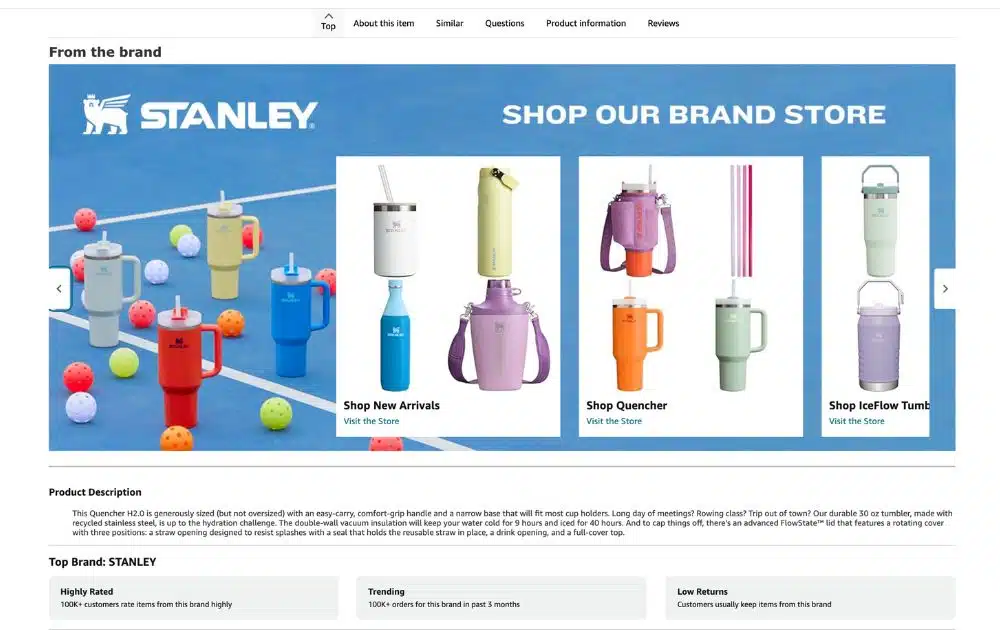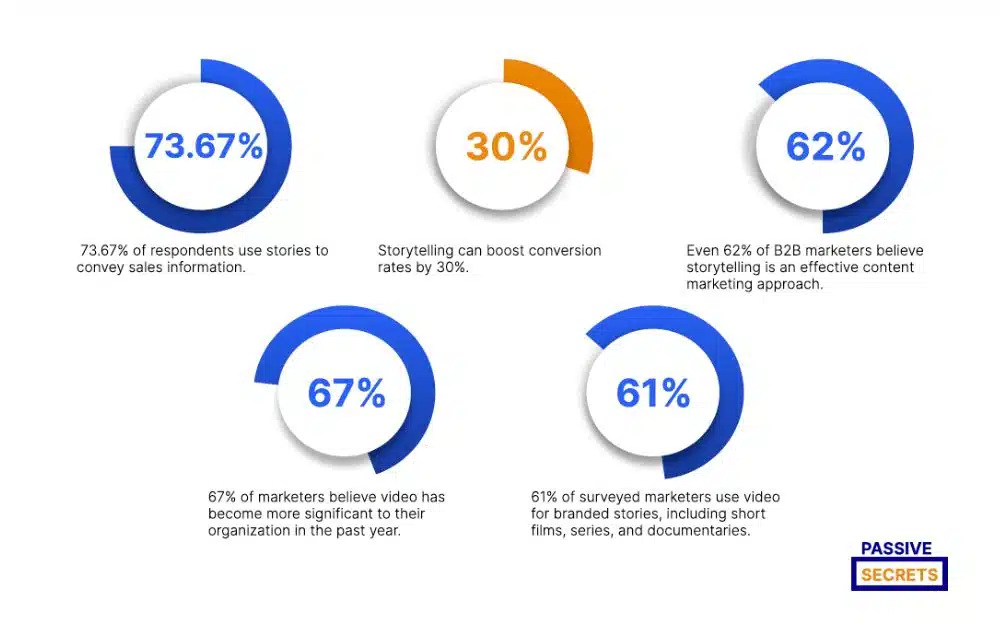Every successful Amazon Brand Story starts with one goal – to transform a product listing from just another option into an experience that emotionally connects with the audience.
It’s more than just a store feature; brand stories allow sellers to project their Amazon branding and build brand trust and loyalty.
Let’s see why you should invest time in a Brand Story on Amazon. We’ll also discuss how to build one, and best practices to ensure that all your efforts pay off.
What is an Amazon Brand Story?
An Amazon Brand Story is a feature within Amazon’s A+ Content that allows sellers to craft a personalized, visual narrative about their brand. This section uses a series of scrolling modules to showcase a brand’s values, mission, and journey.
I browsed Amazon and looked for the top best-selling product under Kitchen and Dining as of writing time, and found it to be a Stanley tumbler. I checked the product page, and lo and behold ― it features a Brand Story:

As seen from the example, the Brand Story acts as a bridge to the rest of Stanley’s product catalog, linking customers to other items they might be interested in, as well as the Stanley Amazon Store.
This approach not only boosts visibility but also aligns with Amazon A+ Content guidelines, which recommend using consistent, high-quality visuals and concise storytelling to resonate with customers.
Why Invest Time in an Amazon Brand Story?
Investing time in an Amazon Brand Story is all about shaping a trustworthy identity for your brand that resonates with customers. Here’s why it’s worth the effort:
Establishing Identity and Trust
By following Amazon Brand Story guidelines and creating a cohesive narrative, brands can humanize their image, sharing their mission, history, and values in a way that’s both authentic and relatable.
According to how to create A+ Content strategies, this emotional connection is vital. Studies suggest customers are more likely to remember and buy from brands they feel connected to. Brand stories help achieve this by inviting buyers to learn about the brand on a personal level.
Boosting Visibility and Cross-Selling Opportunities
The Brand Story’s modular format allows brands to link directly to their Amazon Storefront and showcase multiple ASINs. Thus creates an opportunity to drive traffic across their product catalog.
By guiding customers through related items and collections, sellers can increase order values and encourage browsing, making the most of each shopper’s visit.
Increasing Conversion Rates
Studies show that storytelling can increase conversion rates by as much as 30%, as it helps customers feel more connected to the brand and confident in their purchase decisions.

In fact, 73.67% of marketers report using stories to convey sales information, leveraging narrative techniques to enhance product appeal, and encourage a buy-in from customers.
By taking the time to craft a compelling Brand Story, sellers can tap into this high-conversion strategy, fostering a connection that makes customers more likely to choose them over competitors.
Overview of Amazon Brand Story Modules
Amazon offers a variety of modules to help sellers craft a visually rich and authentic narrative. Here’s a breakdown of each module and how to build brand trust on Amazon using them:
Brand Carousel Background
The Brand Carousel Background module spans the width of the page and acts as a backdrop for other modules, making it crucial to select an image that reflects your brand’s personality.
Using this module thoughtfully can instantly capture attention and establish credibility, showing customers that you’ve invested in high-quality visuals and branding. This is an essential step in how to build brand trust from the very first scroll.
Brand ASIN & Store Showcase
This module is perfect for cross-selling related products by allowing you to feature up to four ASINs and link directly to your Amazon Storefront. It’s an ideal way to guide customers through a broader product catalog and highlight popular items or complementary products.
One of the examples that show this module is the Stanley tumbler product page featured earlier. The brand story featured various clickable images that cross-sell other offerings from the brand.
Brand Focus Image
The Brand Focus Image module emphasizes visual storytelling with a single image and accompanying text. This module is perfect for capturing the essence of your brand, using lifestyle photos, product images, or graphics that convey unique qualities or values.
Here’s an example of a Brand Focus Image module:

As seen from the example, you can use this module to make your story feel genuine and build an emotional connection with your audience.
Brand Logo & Description
This module allows you to display your brand’s logo alongside a brief description of your history, mission, or unique selling points.
The Brand Logo and Description module is essential for branding consistency, helping customers instantly recognize your logo and understand what sets you apart.
Brand Q&A
The Brand Q&A module enables brands to address customer inquiries by answering frequently asked questions. You can either select common questions or add custom ones that highlight your brand’s commitment to quality and customer satisfaction.
This module not only enhances the shopping experience but also helps build trust by showing that your brand is transparent and attentive to customer needs.
Steps to Create a Compelling Amazon Brand Story
Here’s how to design a compelling Brand Story that resonates with your audience and maximizes the impact of your A+ Content:
Access the A+ Content Manager
Log in to Amazon Seller Central and navigate to the A+ Content Manager under the Advertising tab. Select “Create A+ Content” and choose “Brand Story” to get started.
- Actionable tip. Ensure you’re brand registered, as this is a requirement to access the Brand Story feature.
Plan Your Story and Content Strategy
Before selecting modules, outline your brand’s mission, values, and history. Think about the key messages that differentiate you and resonate with your target audience. Highlight unique qualities that reflect why customers should choose your brand.
You may also want to include links to your Amazon storefront or external site to direct traffic outside Amazon when appropriate. This approach not only builds awareness but can encourage potential buyers to explore your full catalog.
Select and Customize Brand Story Modules
Review Amazon’s Brand Story modules and select options that align with your story and products. After which, arrange them in a way that tells a clear, compelling narrative.
- Actionable tip. Use high-quality images, lifestyle visuals, and concise text in each module to keep the brand’s identity cohesive and visually appealing. This combination is crucial for reinforcing recognition and trust.
Optimize for Mobile Viewers
A significant portion of Amazon’s audience shops on mobile, so ensure your story is optimized for smaller screens. Choose visuals that display well on mobile, and consider adding directional cues like “swipe to explore” to improve user experience.
Here’s an example of a Brand Story as viewed from a mobile phone:

Include Calls-to-Action (CTAs)
Alongside complying with Amazon brand guidelines, use CTAs within your Brand Story to guide customers to additional products or your storefront. This can boost visibility and is effective for cross-selling complementary items.
- Actionable tip. Use Amazon’s analytics tools to monitor the performance of your Brand Story, including impressions, click-through rates, and sales. This data can help you refine your approach and optimize future content, driving stronger engagement and conversions.
Best Practices for a Successful Brand Story
Here are some best practices to ensure your Amazon Brand Story makes a lasting impact:
Follow Amazon Brand Guidelines for Consistency
Make sure that you adhere to Amazon’s brand guidelines, specifically for:
- Images
- Text limits
- Layout
Doing so will ensure that your Brand Story looks polished and professional as you build a brand on Amazon.
Capture Attention with High-Quality Visuals
Invest in beautiful, high-resolution images that tell your brand’s story at a glance. For example, use the Brand Carousel Background to showcase lifestyle images that represent your values or product quality.
You can also use powerful visuals to highlight key qualities, like sustainability or craftsmanship, to draw in and retain customer attention.
Review Successful Amazon Brand Story Examples
Look at examples from other successful Amazon Brand Stories and take inspiration from them. Take note of they use the following elements to capture their audience’s interest:
- Visuals
- Storytelling
- Module arrangement
By observing what works well, you can gather ideas and inspiration for refining your own Brand Story.
The Bottom Line
An Amazon Brand Story is more than just a section on a product page—it’s a strategic asset that brings your brand to life, builds trust, and fosters customer loyalty.
By following best practices, adhering to Amazon brand guidelines, and leveraging each module to its fullest, you can create a Brand Story that resonates and leaves a lasting impression.
If you need guidance on other aspects of managing your Amazon business, reach out to AMZ Advisers. With expertise in branding and marketing, our specialists can guide you through creating a powerful brand that resonates with your audience.
Author
 Carla Bauto Deña is a journalist and content writer producing stories for traditional and digital media. She believes in empowering small businesses with the help of innovative solutions, such as ecommerce, digital marketing, and data analytics.
Carla Bauto Deña is a journalist and content writer producing stories for traditional and digital media. She believes in empowering small businesses with the help of innovative solutions, such as ecommerce, digital marketing, and data analytics.



